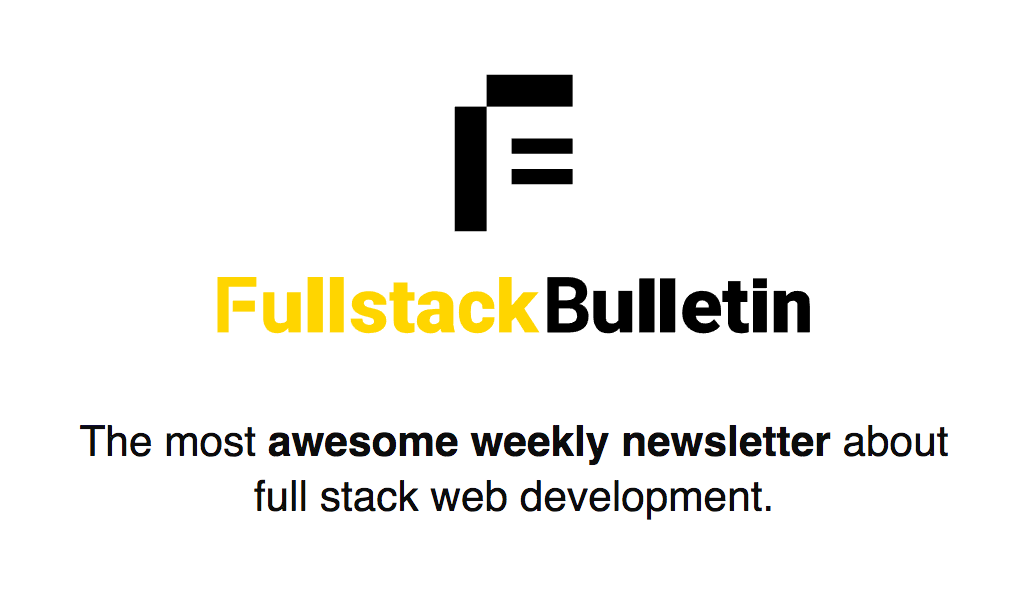
Rome 24-25 MARCH 2017
{ Universal JS Web Applications with React
Luciano Mammino



Who is LUCIANO


Agenda
- The term "Universal" JS
- Who & Why
- Common problems and technologies
- Building a frontend only Single Page App
- Making it universal

ISOMORPHIC
UNIVERSAL WHAT?
not only
for the web...
- Desktop applications
- Mobile applications
- Hardware!
Advantages
of universal javascript
- "JavaScript-only" development
- Maintainability
- Better SEO
- Faster "perceived" load time
Advantages...
more
-
Keep using React/JS paradigms also to generate "static" websites
-
Speed up content loading with linkprefetch
In the wild




it Looks great but...

Module Sharing
Use Node.js modules in the browser
Universal Rendering
Render the views of the application from the server (first request) and then in the browser (next requests)
Universal ROUTING
Recognise the view associated to the current route from both the server and the browser.
Universal DATA RETRIEVAL
Access data (and APIs) from both the server and the browser.
Universal STATE MANAGEMENT
Manage changes on the state tree both on the server and the client...
Futuristic/ALTERNATIVE JS?!









OK...
LET'S Stop complaining and build something!

What are we going to build?

v 2.0

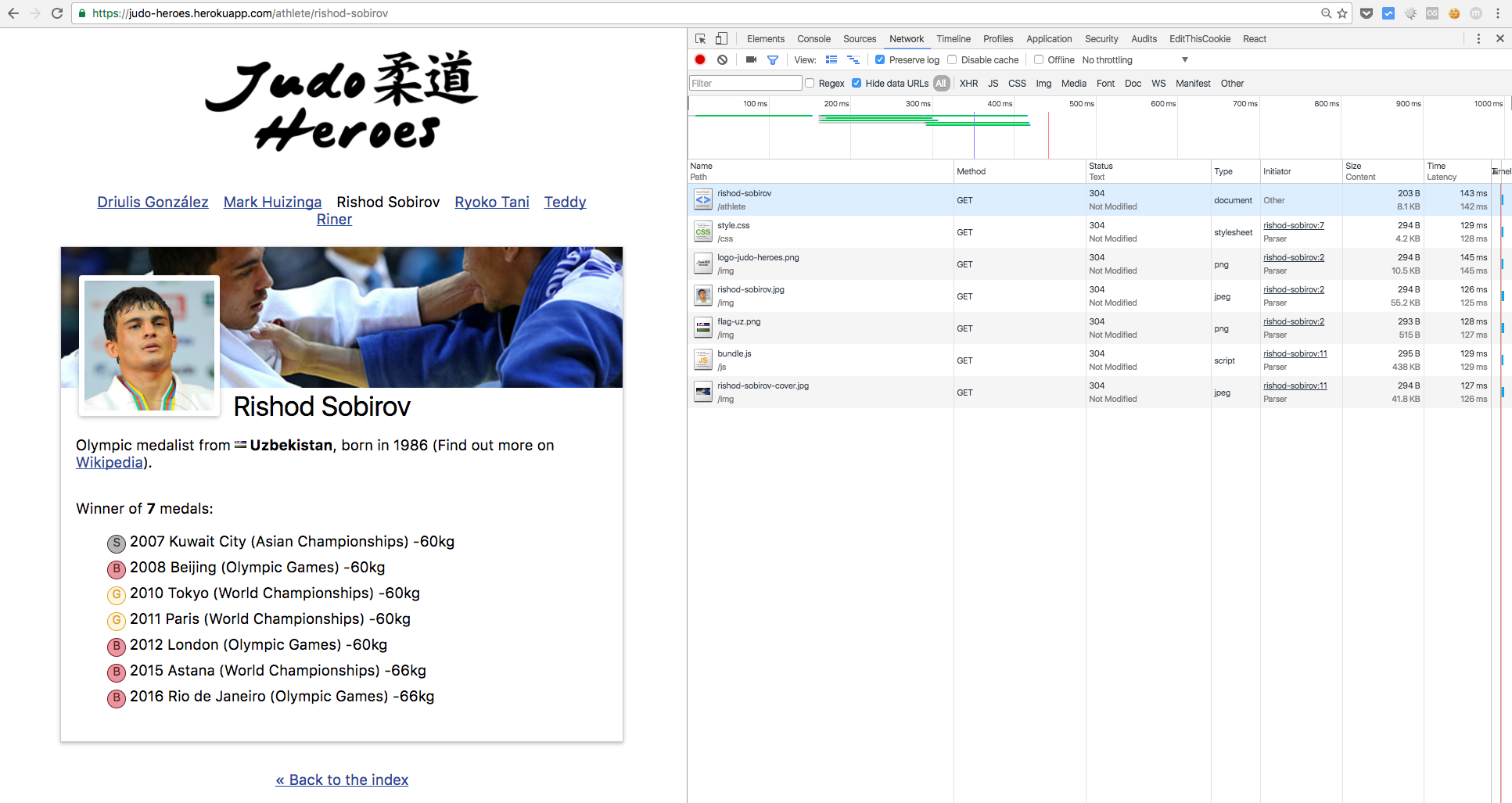
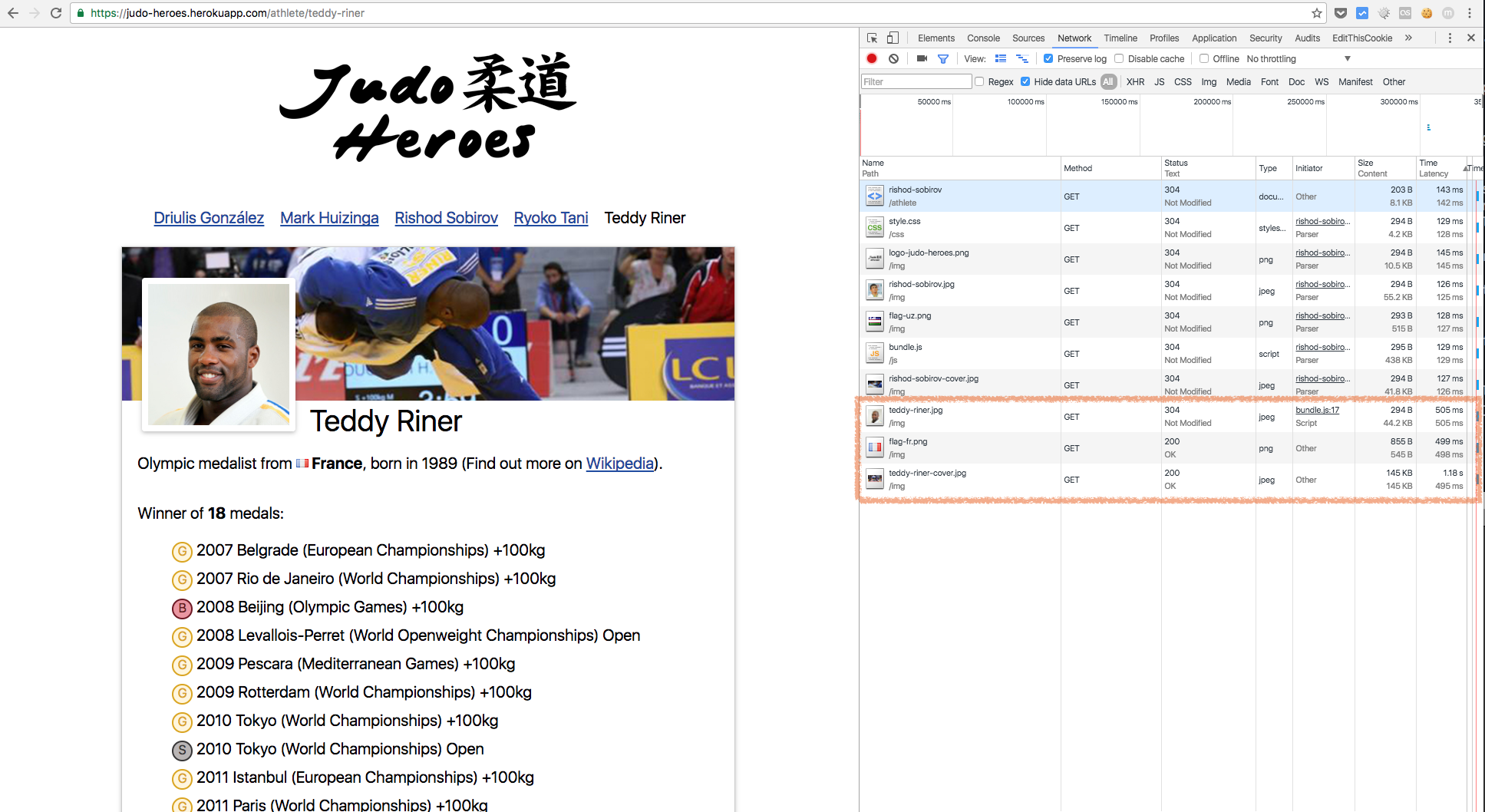
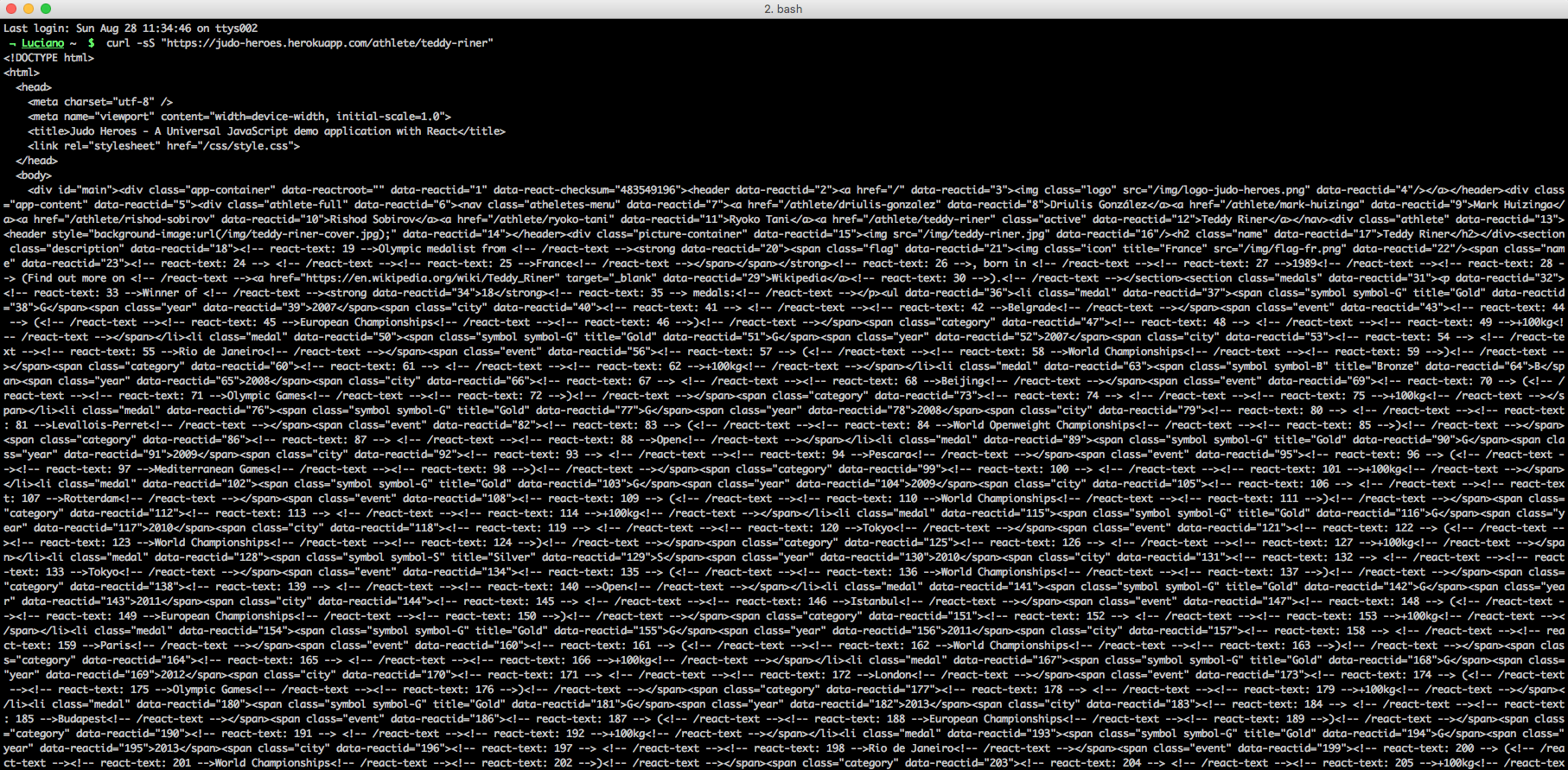
curl -sS "https://judo-heroes.herokuapp.com/athlete/teddy-riner"
What tools are we going to use?

v2
v15.4
v4
v5-alpha
Dependencies 😺
yarn add \
babel-cli@6.18.0 \
babel-core@6.18.2 \
babel-preset-es2015@6.18.0 \
babel-preset-react@6.16.0 \
ejs@2.5.2 \
express@5.0.0-alpha.5 \
react@15.4.2 \
react-dom@15.4.2 \
react-router-dom@4.0.0 \
webpack@2.2.1
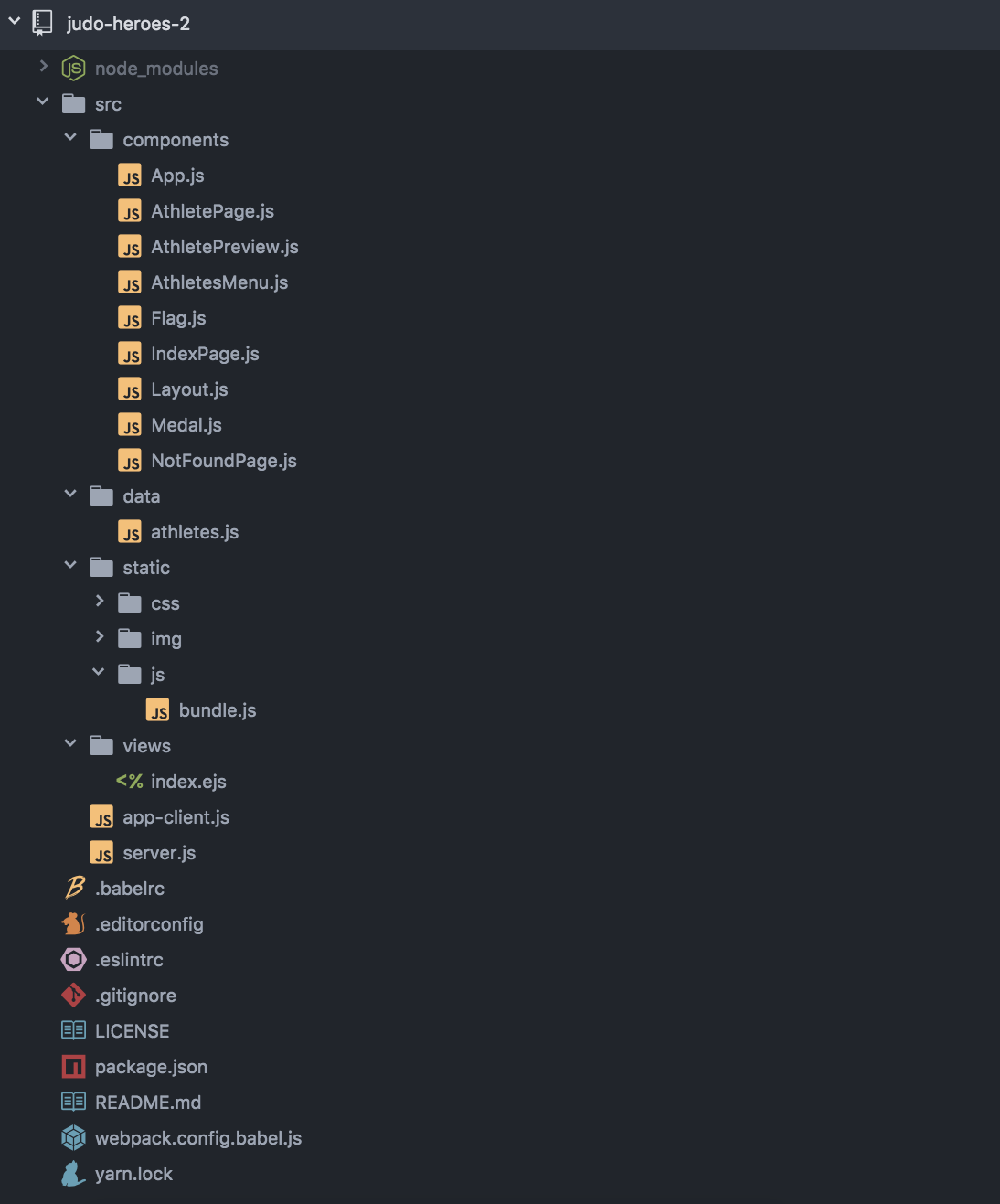
React components
Data files
Static resources
Views (HTML templates)
Client side app
Server side app
Config, Metadata, etc.
The data set
// src/data/athletes.js
const athletes = [
{
id: 'driulis-gonzalez',
name: 'Driulis González',
country: {
id: 'cu',
name: 'Cuba',
icon: 'flag-cu.png',
},
birth: '1973',
image: 'driulis-gonzalez.jpg',
cover: 'driulis-gonzalez-cover.jpg',
link: 'https://en.wikipedia.org/wiki/Driulis_González',
medals: [
{ id: 1, year: '1992', type: 'B', city: 'Barcelona', event: 'Olympic Games', category: '-57kg' },
{ id: 2, year: '1993', type: 'B', city: 'Hamilton', event: 'World Championships', category: '-57kg' },
{ id: 3, year: '1995', type: 'G', city: 'Chiba', event: 'World Championships', category: '-57kg' },
{ id: 4, year: '1995', type: 'G', city: 'Mar del Plata', event: 'Pan American Games', category: '-57kg' },
{ id: 5, year: '1996', type: 'G', city: 'Atlanta', event: 'Olympic Games', category: '-57kg' },
// ...
],
},
// ...
];
export default athletes;React components
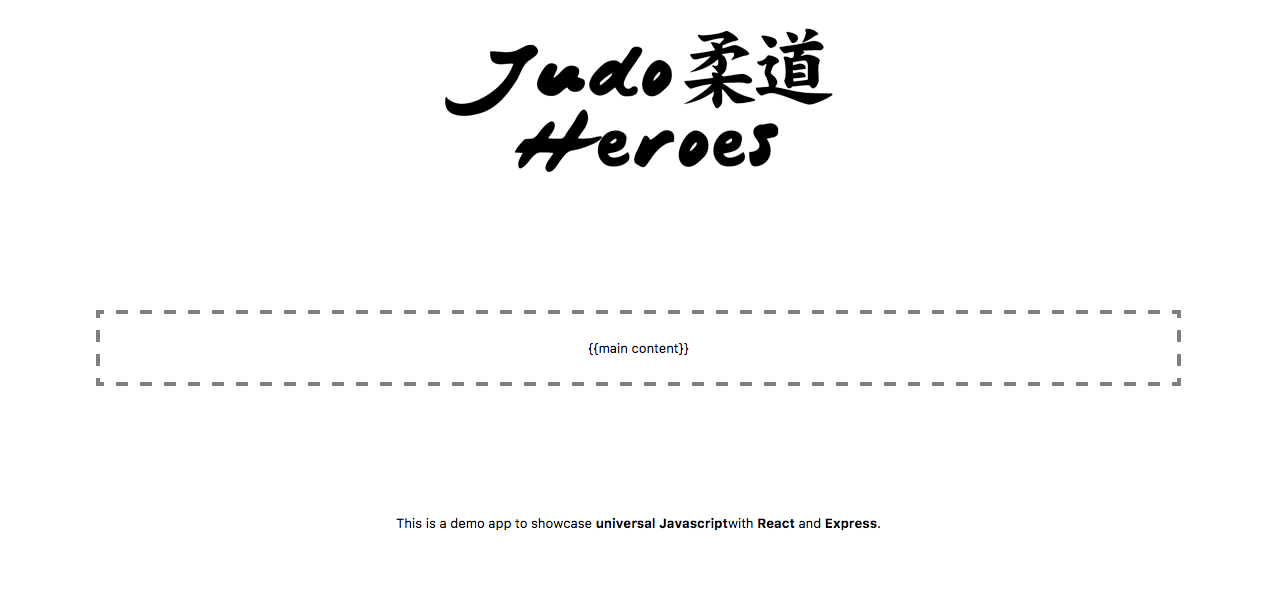
Layout component
IndexPage component

AthletePage component
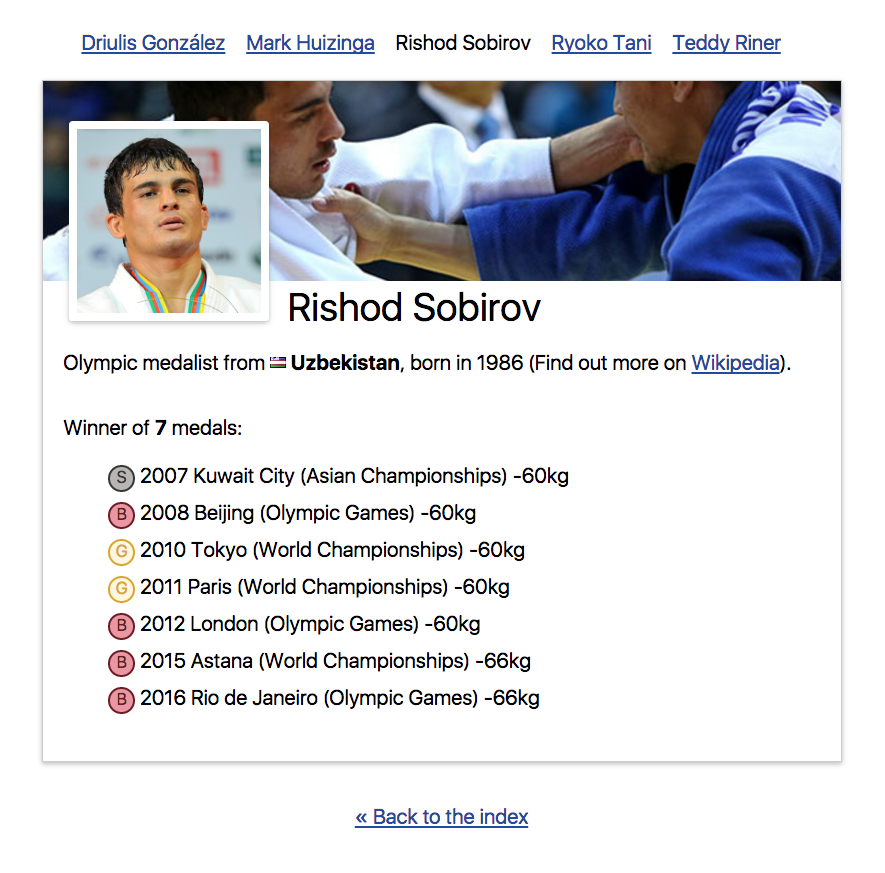
NotFoundPage component

AthletePreview component

AthletesMenu component

Flag component

Medal component

// src/components/Layout.js
import React from 'react';
import { Link } from 'react-router-dom';
export const Layout = props => (
<div className="app-container">
<header>
<Link to="/">
<img className="logo" src="/img/logo-judo-heroes.png" />
</Link>
</header>
<div className="app-content">{props.children}</div>
<footer>
<p>
This is a demo app to showcase
<strong>universal Javascript</strong>
with <strong>React</strong> and
<strong>Express</strong>.
</p>
</footer>
</div>
);
export default Layout;
// src/components/IndexPage.js
import React from 'react';
import { AthletePreview } from './AthletePreview';
export const IndexPage = ({ athletes }) => (
<div className="home">
<div className="athletes-selector">
{
athletes.map( athleteData =>
<AthletePreview
key={athleteData.id}
{...athleteData} />
)
}
</div>
</div>
);
export default IndexPage;
// src/components/AthletePreview.js
import React from 'react';
import { Link } from 'react-router';
export const AthletePreview = (props) => (
<Link to={`/athlete/${props.id}`}>
<div className="athlete-preview">
<img src={`img/${props.image}`}/>
<h2 className="name">{props.name}</h2>
<span className="medals-count">
<img src="/img/medal.png"/> {props.medals.length}
</span>
</div>
</Link>
);
export default AthletePreview;
ROUTING
2 routes
Index Page: / Athlete Page: /athlete/:id
// src/components/App.js
import React from 'react';
import { Route, Switch } from 'react-router-dom';
import { Layout } from './Layout';
import { IndexPage } from './IndexPage';
import { AthletePage } from './AthletePage';
import { NotFoundPage } from './NotFoundPage';
import athletes from '../data/athletes';
// ...
export const App = () => (
<Layout>
<Switch>
<Route exact path="/" render={renderIndex} />
<Route exact path="/athlete/:id" render={renderAthlete} />
<Route component={NotFoundPage} />
</Switch>
</Layout>
);
export default App;// src/components/App.js
// ...
const renderIndex = () => <IndexPage athletes={athletes} />;
const renderAthlete = ({ match, staticContext }) => {
const id = match.params.id;
const athlete = athletes.find(current => current.id === id);
if (!athlete) {
return <NotFoundPage staticContext={staticContext} />;
}
return <AthletePage
athlete={athlete}
athletes={athletes} />;
};Client APP
// src/app-client.js
import React from 'react';
import { render } from 'react-dom';
import { BrowserRouter as Router } from 'react-router-dom';
import { App } from './components/App';
const AppClient = () => (
<Router>
<App />
</Router>
);
window.onload = () => {
render(
<AppClient />,
document.getElementById('main')
);
};HTML TEMPLATE
// src/views/index.ejs
<!DOCTYPE html>
<html>
<head>
<meta charset="utf-8" />
<meta name="viewport"
content="width=device-width, initial-scale=1.0">
<title>
Judo Heroes - A Universal JavaScript demo application with React
</title>
<link rel="stylesheet" href="/css/style.css">
</head>
<body>
<div id="main"><%- markup -%></div>
<script src="/js/bundle.js"></script>
</body>
</html>
BUILD CONFIG
(BABEL + WEBPACK)
.babelrc
import path from 'path';
const config = {
entry: {
js: './src/app-client.js',
},
output: {
path: path.join(__dirname, 'src', 'static', 'js'),
filename: 'bundle.js',
},
module: {
rules: [
{
test: path.join(__dirname, 'src'),
use: { loader: 'babel-loader' },
},
],
},
};
export default config;
.webpack.config.babel.js
{
"presets": ["react", "es2015"]
}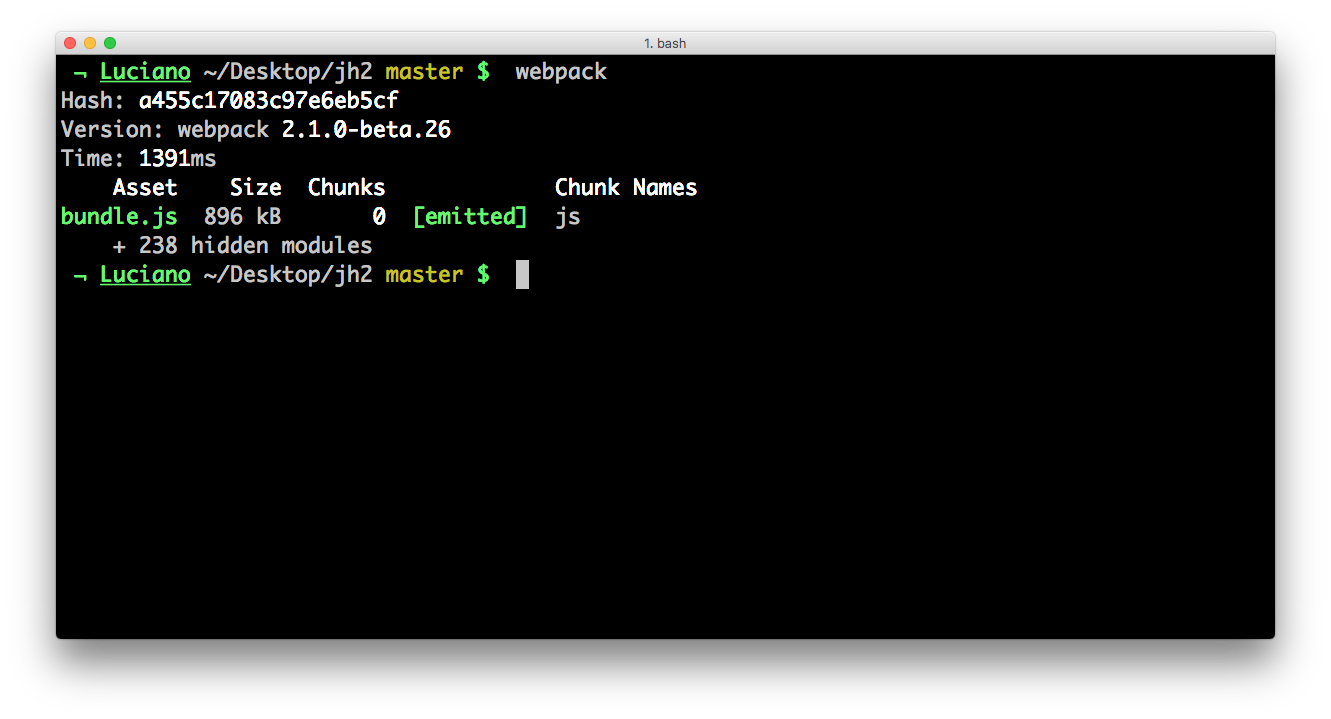
Let's build it!
// src/server.js
import path from 'path';
import { Server } from 'http';
import Express from 'express';
const app = new Express();
const server = new Server(app);
// use ejs templates
app.set('view engine', 'ejs');
app.set('views', path.join(__dirname, 'views'));
// define the folder that will be used for static assets
app.use(Express.static(path.join(__dirname, 'static')));
// render the index for every non-matched route
app.get('*', (req, res) => {
let markup = '';
let status = 200;
return res.status(status).render('index', { markup });
});
// start the server
const port = process.env.PORT || 3000;
const env = process.env.NODE_ENV || 'production';
server.listen(port);"Static" Express server
Ready... LET's TEST IT

RECAP
What we learned so far
- Define views combining React components
- Add routing using React Router
- Compile the client bundle with Babel and Webpack
- Run the app with a static Express server
SERVER SIDE RENDERING AND ROUTING
Updating the server app
// ...
import { renderToString } from 'react-dom/server';
import { StaticRouter as Router } from 'react-router-dom';
import { App } from './components/App';
// ...
app.get('*', (req, res) => {
let markup = '';
let status = 200;
const context = {};
markup = renderToString(
<Router location={req.url} context={context}>
<App />
</Router>,
);
// context.url will contain the URL to
// redirect to if a <Redirect> was used
if (context.url) {
return res.redirect(302, context.url);
}
if (context.is404) {
status = 404;
}
return res.status(status).render('index', { markup });
});That's it!
LET's TEST again

RECAP
What we learned so far
- Create a Single Page Application with React and React Router
- Add server side routing and rendering using React and React Router libraries in the Express app
universal data retrieval
api-proxy & async-props
(COMPLETE CHAPTER in Node.js Design Patterns)
universal state management
Redux
Where do we go
from here...
Code: loige.link/judo-heroes-2
THANKS!

(Special thanks to @cirpo, @andreaman87, Aleksandar Čambas & @quasi_modal)





